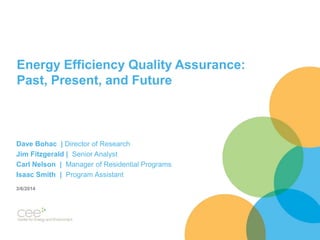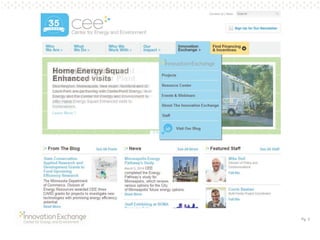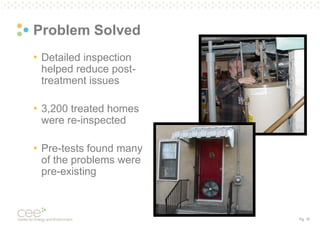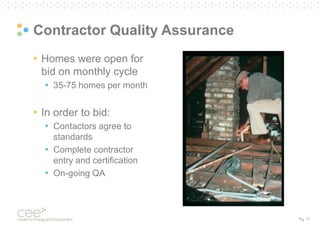Energy Efficiency Quality Assurance
- 1. Energy Efficiency Quality Assurance: Past, Present, and Future Dave Bohac | Director of Research Jim Fitzgerald | Senior Analyst Carl Nelson | Manager of Residential Programs Isaac Smith | Program Assistant 3/6/2014
- 2. Pg. 2
- 3. Pg. 3
- 4. Pg. 4 Meeting Utility Resource Needs with Solar: The Merits of the Aurora Solar Project Wednesday, March 19th 11:00 – 12:00 CST Betsy Engelking | Geranimo Energy Vice President Nathan Franzen | Geranimo Director of Solar • Introduction to the Aurora Solar Project that has been selected in MN • The design and technical merits of the proposed project
- 5. Pg. 5 Presenters & Overview • Experience that have informed best practices • Innovations currently being used in the field • Future implementation opportunities Dave Bohac Director of Research Jim Fitzgerald Senior Research Analyst Carl Nelson Manager of Residential Programs Isaac Smith Program Assistant
- 6. Pg. 6 Operation Insulation • Beginning of Quality Assurance (QA) at CEE • ~1983
- 7. Pg. 7 Community Based Outreach • One-stop shop for home improvement
- 8. Pg. 8 Partnered with contractors • Agreed to standards
- 9. Pg. 9 Post Inspection • Every job was inspected • Borrowed IR camera from fire department and Hughes Aircraft • Cooled with argon gas
- 10. Pg. 10 Operation Insulation • Over 4,000 homes participated • Funded by Minnegasco
- 11. Pg. 11 Sound Insulation Program • Began in 1992 to reduce airport noise • CEE hired to administer the program • Funded by the Federal Aviation Administration (FAA) and Metropolitan Airports Commission (MAC) • Over 13,000 homes participated over next decade • Work completed: • Acoustic windows and doors • Air-Conditioning • Attic insulation and air-sealing • Wall insulation
- 12. Pg. 12 Health and Safety • 1996 Headline
- 13. Pg. 13 Health and Safety • Indoor Air Quality (IAQ) issues discovered in treated homes • 3,200 homes had completed the program by 1996 • Issues of concern: • Gas appliance combustion spillage • Gas appliance carbon monoxide • House tightness/ventilation
- 14. Pg. 14 Program Response • Temporarily suspend program • Assemble panel of international experts • Led by Dave Bohac • Design process to predict and resolve possible issues • CEE developed inspection and testing standards • “Worst-case” testing of natural and induced-draft appliances • Carbon monoxide testing for each appliance • Pass/Fail limits set • Compare vent system size to code • Establish house tightness criteria
- 15. Pg. 15 Ventilation standards • Sound ventilation requirement developed • Air leakage (cfm50) < Floor area (sf) • Add continuous exhaust ventilation • Predicting the future • 10% to 35% reduction expected
- 16. Pg. 16 Problem Solved • Detailed inspection helped reduce post- treatment issues • 3,200 treated homes were re-inspected • Pre-tests found many of the problems were pre-existing
- 17. Pg. 17 Contractor Quality Assurance • Homes were open for bid on monthly cycle • 35-75 homes per month • In order to bid: • Contactors agree to standards • Complete contractor entry and certification • On-going QA
- 18. Pg. 18 Why is it important to have an entry process for new contractors? • Initial process was incomplete • Two process issues • Contractor agreement to meet program work requirements • Contractor’s staff may not know requirements or how to meet them • Entry process informs contractors and installers • Pre bid demonstration on first jobs • Crew has chance to demonstrate compliance • Required tasks were the same as the QA test by CEE
- 19. Pg. 19 Contractor Entry • 5 test jobs before contractor on bid list • QA assessor verifies skills on-site • Required skills • Effective air sealing of bypasses • Dense-pack insulation, equipment test • Blower door test • Contractor training as necessary • Bid limit removed once skills verified • Basic certification of each installer recorded
- 20. Pg. 20 Quality Assurance • Every job inspected using blower door and IR camera • Contractor Requirements • Maintain 90% pass rate • Correct jobs within 14 days • Failure to comply => off bid list If necessary, another contractor completed all work before CEE final test • Over 13,000 homes inspected complete in full compliance
- 21. Pg. 21 Evolution of Standards • Not part of code at the time, only voluntary standards • “best practices” developed in funded pilot programs • Had to be adapted locally • Learned from other programs • Adapted this process for other Sound Insulation programs, including Milwaukee • This process contributed to the development of national standards • M200/advanced WX • BPI and NYSERDA
- 22. Pg. 22 5 Keys of QA program 1. Installation Standards 2. Contractor Participation Agreement 3. Verify contractor ability 4. Verify work completed to standards 5. Contractor Accountability
- 23. Pg. 23 Authorized Insulation Contractor Program 1. Installation Standards • Adapted from Sound Insulation Program 2. Contractor Participation Agreement • Own required equipment • Complete work to standards • QA visits and callback completion • Blower door and combustion safety testing • Customer service Note: Contractor needs incentive
- 24. Pg. 24 Authorized Insulation Contractor Program 3. Verify contractor ability • Building Performance Institute (BPI) Installer certification • Official name: Residential Building Envelope Whole House Air Leakage Control Installer Certification • Skills based certification developed by Jim Fitzgerald • Certified employee must be on-site
- 25. Pg. 25 Authorized Insulation Contractor Program 4. Verify work completed to standards • QA phone visits • Complete on initial jobs • QA on-site visits • Check a sample of jobs • QA site visit app • Data entered on-site using iPad • Database of info • Generates visit report including score • Provides contractor feedback
- 26. Pg. 26 Authorized Insulation Contractor Program 5. Contractor Accountability • Requirements • Maintain acceptable job score • Complete required callback work • Probation • Additional QA phone visits • On-line training portal • Also used during contractor entry • Suspension • Removed from program if requirements are not met
- 27. Pg. 27 Authorized Insulation Contractor Program • Further Details on program website • http://mncee.org/AIC/ • Questions? • ismith@mncee.org
- 28. Pg. 28 Future trends in residential QA • Increased need for QA -- utilities need insulation programs & rebates to meet savings goals, and potential for bad contractors not going away • But, delivered at low cost --- Long-term low natural gas prices drive increased need for efficiency in delivery of QA services • Technology can lower cost and enhance performance • Software • Web-based training • Increased need for coordination • Regional technical committees for coordination / continued refinement of standards
- 29. Dave Bohac | dbohac@mncee.org Jim Fitzgerald | jfitzgerald@mncee.org Carl Nelson | cnelson@mncee.org Isaac Smith | ismith@mncee.org
- 30. Question & Answer Webinar Link: http://www.mncee.org/Innovation-Exchange/Resource-Center/
- 31. Pg. 31
Editor's Notes
- http://www.irinfo.org/articles/12-1-2013-kochanek.htmlArgon gas cooling
- We took what we learned from Operation Insulation and took that to another level for the sound insulation program that we managed for the Minneapolis – St. Paul airport. The project started in 1992 with the goal to reduce the impact of airport noise on the residences around the airport. The work was funded by the FAA and the Metropolitan Airports Commission. The program treated over 13,000 homes.This work included the installation of acoustic windows and doors and air conditioning for the homes that didn’t have functioning AC. It also included attic and wall insulation and attic bypass sealing. So we had many of the same issues with insulation contractor quality control that low-income weatherization and utility programs have. Except in our case the program had a very high profile.
- For example, in 1996 I woke up one Saturday morning to the following headline – not exactly how I had hoped to start my weekend. It turns out that five of the houses that had been sound insulated had some combustion safety issues and there were concerns that some of the houses had gotten overly tight.No one wants to have this kind of press for a program that is intended to benefit households. Much in the same way that you wouldn’t want a LIWX or utility program having complaints about poor work by insulation contractors.
- In this case the main issues were furnace and water heater combustion gas spillage and carbon monoxide. The concern was that they could down draft or spill as the houses were tightened. In addition, tighter houses could mean that infiltration through house leaks wouldn’t be enough to properly ventilate the houses.At that time the program had treated 3,200 homes, so this was a significant concern.
- MAC took this very seriously. They suspended the program and brought in a group of international experts including a couple of local people - David Grimsrud and Matt Wilber. We established a comprehensive test and design process to assure that any combustion safety and ventilation issues were addressed. The tests included worst-case combustion spillage & carbon monoxide under normal and down-draft conditions. We established pass/fail criteria for those tests. The tests were performed when the houses were coming into the program and repeated after the insulation work was completed. The homeowners had to address any pre-existing failures and the program paid for remediation for work due to house tightening. In fact, we tried to anticipate problems as much as possible and design the solution into the retrofit package.With experience we found that many of the combustion vent systems were undersized or improperly installed. So we compared the connector and chimney sizes to code requirements to determine our recommendations.We also established a house tightness criteria to determine when mechanical ventilation was required.
- At that time there wasn’t an established guideline or standard for house tightness. We based ours on a comparison of the house floor area to the blower door cfm50. We added either bathroom or kitchen exhaust fans that were quiet and rated for continuous operation. We based the ventilation design on the current house tightness and our experience of how much the house would be tightened by the program measures – which was 10% for tighter houses and up to 35% for leakier houses.
- After we implemented the test and design process we had very few “failures” when the work was completed. In addition to using the new process for all of the incoming houses, we also went back and tested the 3,200 houses that had already been treated.An interesting outcome of the project was many of the problems were pre-existing. So what was originally thought were problems caused by the sound program were already present before the houses were treated.
- That effort was focused on indoor air quality or combustion safety and ventilation.This same level of quality control was applied to our insulation contractors. We were working with 35 to 75 additional houses each month. So this was seen as a significant business opportunity for insulation contractors and many contractors were interested in getting involved. We established a comprehensive process for the work standards, initial training/certification, quality assurance inspections, and performance level required to remain in the program.
- Experience boiled down to 5 keys of QA programEstablish standards, have contractor agree to standards…
- Applied these keys to MER AIC program, a QA program for their air sealing and insulation rebate program. Adapted from sound include 20 pages on material and installation requirementsContractors must agree to complete work to standards as well as other requirements you would like for your program…examples hereNeed incentive: AIC must be on list to offer MER rebate, sound and OI produced a lot of business for contractors
- 3rd key verify abilityRequire the BPI installer certificationHands on skills based certification where contractor shows ability to air seal (picture examples) 9 total air sealing and 3 dense packing tasksDeveloped by Jim FitzFor ind crew leader not contractor, person on-site doing the work
- Remote QA procedure, where crew leader uses a smart phone to send pictures. Saves time and money, esp. MER which is very large territory and would require travelComplete on every job in the beginning, important to verify skill early to get on same page about requirementsImportant so you don’t get behind on contractor work, like with post checks, contractor could complete 10 jobs before you have chanceAlso makes scheduling easierComplete on-site once skill verified, also do one on first jobs then complete on a sampleDeveloped QA app where assessor can enter data on site, allows for tracking data and creating database of QA infoApp generates report and score for contractor, gives the contractor feedback on areas to improve and is specific to crew leader, reports can be e-mailed on site
- Need to hold contractor to requirementsMust clearly outline probation and suspension procedures for contractorAIC requires additional QA phone visits so more work is not completed without being checked, get back on same page with crew leaderAlso require on-line training to brush up on testing procedures and requirementsThis is also required during entry to reiterate the training during entryIt is an interactive on-line course that includes short quizesWe are informed when contractors have completed this
- For details visit our websiteIf you have specific question feel free to e-mail me using the address here.






























